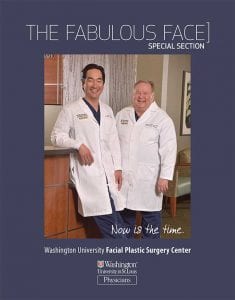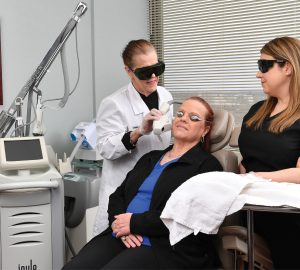If you’ve been noticing unwelcome lines, wrinkles, spots or drooping skin in the mirror this winter, don’t despair. Now is the perfect time to fight back
with facial rejuvenation treatments, the experts say.
“As our facial skin ages, we normally see three things: sagging, lower skin volume due to bone loss around the jaw and eyes, and texture issues like lines and wrinkles,” says Dr. Gregory Branham, chief of facial plastic and reconstructive surgery at Washington University School of Medicine. “You inherit your pattern of aging, so everyone is unique in how their skin responds to age. The face also loses moisture and underlying fat and muscle over time, and we all have different levels of sun and other elements we’ve been exposed to.” Many people also notice discolorations such as age spots, known as ‘dyschromias,’ he adds.
Because everyone’s ‘skin factors’ are different, it’s important to meet with a board-certified facial plastic surgeon for a personalized plan to treat your unique issues, Branham says—and the less-hectic winter months are an ideal time to do it. Taking into account your skin quality, age, health, sun exposure and other factors, your doctor can come up with a treatment plan that works best for you.
 If sagging facial skin is an issue, Branham says procedures like mini-lifts or tucks can be considered. For skin volume loss, there are injectable treatments, including those that use the patient’s own fat from other body areas, such as the thighs or abdomen. And for the patient concerned about lines and wrinkles, topical treatments and injectable fillers are options, he notes.
If sagging facial skin is an issue, Branham says procedures like mini-lifts or tucks can be considered. For skin volume loss, there are injectable treatments, including those that use the patient’s own fat from other body areas, such as the thighs or abdomen. And for the patient concerned about lines and wrinkles, topical treatments and injectable fillers are options, he notes.
Patients also may want to consider laser resurfacing and chemical peel procedures, Branham says. “These are more proactive and help rejuvenate, tighten and freshen skin,” he explains. “There are different levels of laser resurfacing that can be used depending on skin quality and how much recovery time you can commit.” Deeper laser treatments stimulate the lower layers of skin to create new collagen and elastin protein to help fill in more pronounced wrinkles, Branham explains. And surface imperfections like fine lines and age spots can be improved with more superficial laser treatments.
Chemical peels create a chemical reaction in the skin that can be tailored for deep or surface results, he adds. Peels exfoliate and reveal a smoother, younger-looking surface beneath. And many patients can benefit from combinations of the above procedures, according to Branham.
Dr. John Chi, facial plastic and reconstructive surgeon at Washington University School of Medicine, agrees that wintertime offers clear advantages for facial treatments, especially those that require a recovery period. Although scarring is minimal with modern procedures, proper healing time is still an important consideration, he notes.
“Our social calendars usually slow down after the holidays and there are fewer reasons to be out in the sun, so it’s a good time for facial procedures,” he says. “Sun exposure can lead to color changes in scars, and it can have implications for wound healing. Though tissues may appear to be healed only a few weeks after treatment, impact from sun exposure can continue for up to a year.”
Chi adds that there are several stages to the process: an initial consultation and decision-making period; finding a mutually convenient schedule; and post-treatment recovery time. “Give yourself enough time to get it done before you need to put your best face forward,” he says.
Pictured: Dr. John Chi and Dr. Gregory Branham
Photo: Mark Gilliland
Washington University’s Facial Plastic Surgery Center offers comprehensive services in facial cosmetic and reconstructive surgery, as well as medical spa treatments. For more information, call 314.996.3800 or visit facialplasticsurgery.wustl.edu.
Cover provided by Washington Unviersity Physicians








